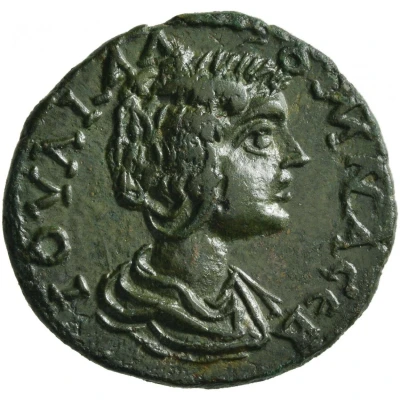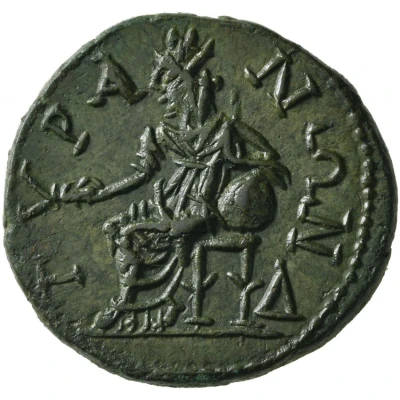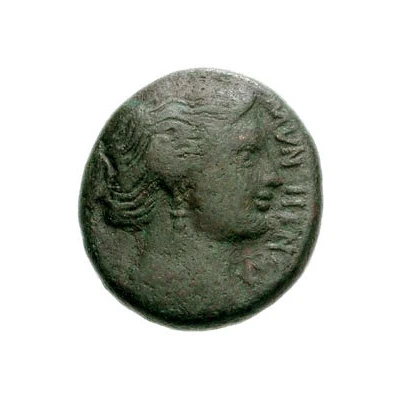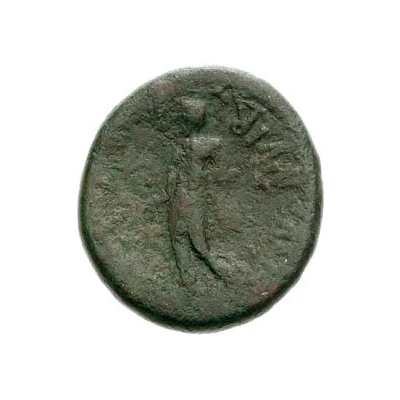![Æ25 - Gaius Sosius[?] (Q; Cilicia) front](/storage/images/25-Gaius-Sosius-Q-Cilicia_413154_1.webp)
![Æ25 - Gaius Sosius[?] (Q; Cilicia) back](/storage/images/25-Gaius-Sosius-Q-Cilicia_413154_2.webp)
![Æ25 - Gaius Sosius[?] (Q; Cilicia) photo](/storage/images/25-Gaius-Sosius-Q-Cilicia_413154_1.webp)
Æ25 - Gaius Sosius[?] Q; Cilicia
| Bronze | 14.28 g | 25.47 mm |
| Issuer | Roman provinces (Rome) |
|---|---|
| Period | Republic (509 BC - 27 BC) |
| Type | Standard circulation coin |
| Currency | Drachm |
| Composition | Bronze |
| Weight | 14.28 g |
| Diameter | 25.47 mm |
| Shape | Round (irregular) |
| Technique | Hammered |
| Orientation | Medal alignment ↑↑ |
| Demonetized | Yes |
| Updated | 2024-10-10 |
| Numista | N#413154 |
|---|---|
| Rarity index | 97% |
Reverse
Fiscus, sella quaestor and hasta
Script: Greek
Lettering: Q
Comment
This enigmatic bronze dates to the late Republic. We're not entirely sure where it was minted or for whom, leaving us to speculate on its origins. Scholars have suggested that this is either Brutus, Julius Caesar, Octavian or the Syrian governor Gaius Sosius.
Julius Caesar and Brutus were two early candidates, both having struck a variety of bronze issues in the east. The reverse showing political items highly resembles that of the questor Aesillas, who struck silver tetradrachms in Macedon during the late 90's to early 70's BC (HGC 3, 1110). The similarities between the two have led some scholars to speculate that the series is Macedonian in origin. M. Grant, in his work "From Imperium To Auctoritas, A Historical Study of Aes Coinage In The Roman Empire, 49 BC-AD 14", proposed that M. Acillus served as governor of Macedonia in 45/44 and struck coins with Caesar's portrait. This is only speculation however and no coins of these types have ever been found in Macedonia.
Our third candidate is Gaius Sosius, a quaestor under Mark Antony in 39. He issued coins on the island of Zacynthus bearing the legend "C SOSIVS Q". These coins coincide with the dating of the series in question, to around 39 BC. Both issues including a Q to denote that the issuer was a questor.
And finally, Octavian, who is the final candidate. The find data available to us supports the mint being somewhere in Asia Minor. There are coins attributed to the region of Cilicia that show remarkable stylistic similiarities to this type. These issues depict a bust of a man looking right, with the legend “PRINCEPS FELIX”, suggesting the person is Augustus. The reverse legend of these types, “VE TER/ COLONIA / IVLIA II VIR“ and “COLONIA/IVLIA, II VIR VE TER” respectively, provides us with the name of a possible mint location (See RPC I 4082, 4083).
RPC I 4082
(Cited from: https://www.cointalk.com/threads/a-mysterious-provincial-of-the-late-republic.383999/)
Interesting fact
One interesting fact about the Standard circulation coin Æ25 - Gaius Sosius[?] (Q; Cilicia) from Roman provinces (Rome) made of Bronze weighing 14.28 g is that it was issued during the reign of Emperor Augustus (27 BC - 14 AD), who was known for his extensive reforms and military campaigns. This coin was likely used in everyday transactions and could have been carried by merchants, soldiers, and other individuals throughout the Roman Empire.




